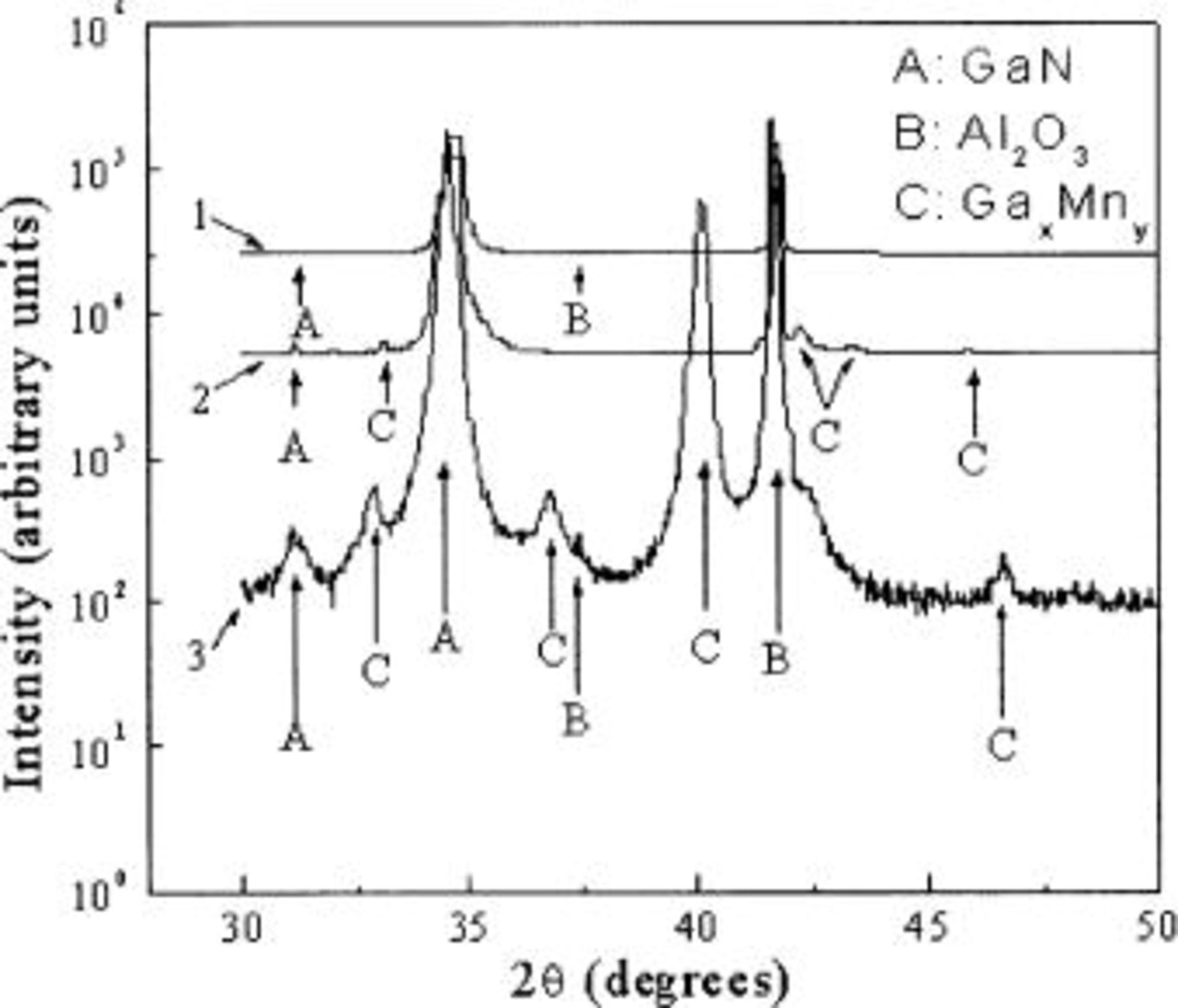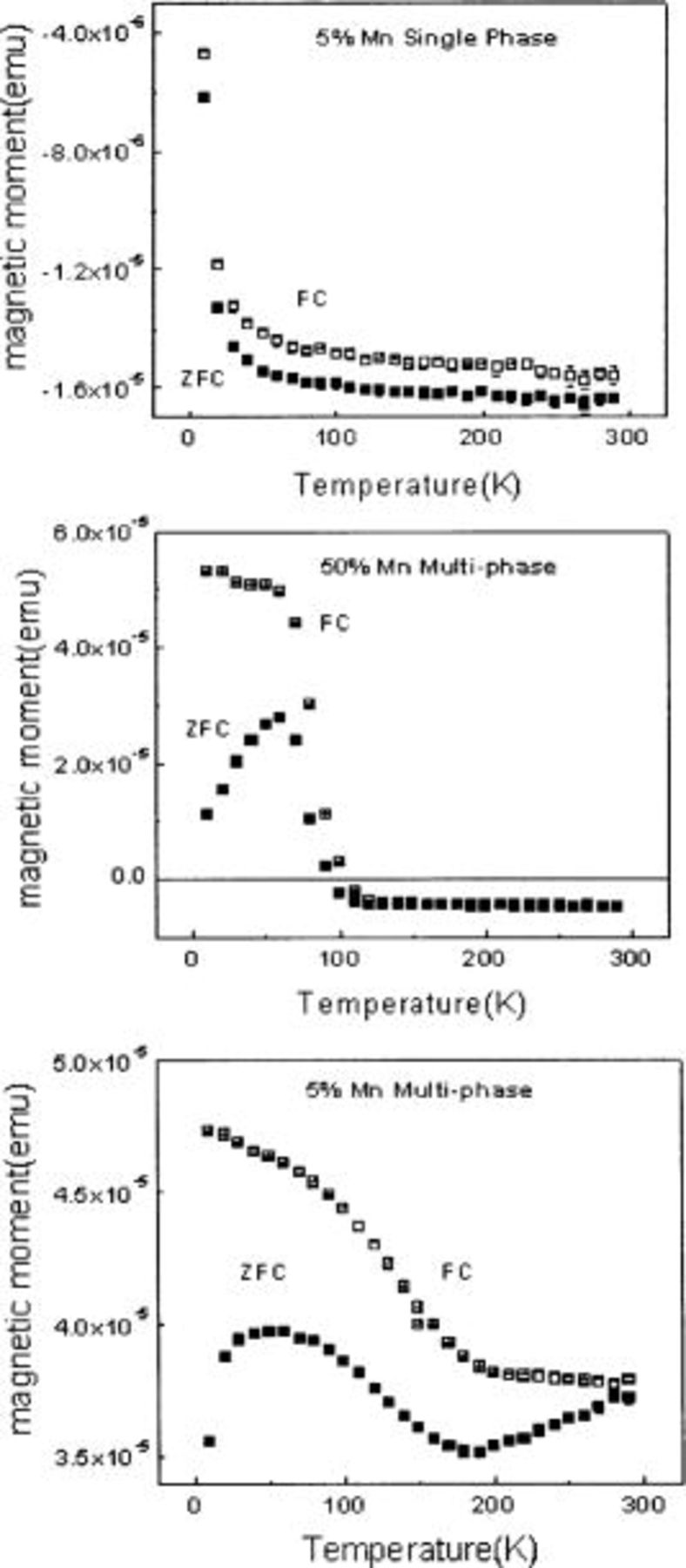Abstract
(Ga, Mn)N layers were grown by radio-frequency plasma-assisted molecular beam epitaxy with Mn concentrations of ∼5 or 50 atom %. In the material doped with 5 atom % Mn, the growth conditions were adjusted to produce second phases in one case, detectable by X-ray diffraction. Under our conditions, the dominant second phases are  -related and not
-related and not  All three types of material (single-phase or GaMn second phases at different concentrations) exhibit 300 K hysteresis in magnetic moment vs. field (M-H) plots, but the temperature dependence of the field-cooled (FC) and zero-field cooled (ZFC) magnetization is quite different in each case. A clear difference in FC-ZFC magnetization at 300 K in the single-phase material is observed. © 2003 The Electrochemical Society. All rights reserved.
All three types of material (single-phase or GaMn second phases at different concentrations) exhibit 300 K hysteresis in magnetic moment vs. field (M-H) plots, but the temperature dependence of the field-cooled (FC) and zero-field cooled (ZFC) magnetization is quite different in each case. A clear difference in FC-ZFC magnetization at 300 K in the single-phase material is observed. © 2003 The Electrochemical Society. All rights reserved.
Export citation and abstract BibTeX RIS
(Ga, Mn)N is a strong candidate for room-temperature dilute magnetic semiconductor (DMS) applications. Numerous groups have reported promising magnetic properties for GaN doped with Mn during growth or by implantation or diffusion.1
2
3
4
5
6
7
8
9
10
11
12
13
14
15
16
17
18
19
20
21 However, there are still strong variations in the reported magnetic behavior, with some films exhibiting only paramagnetism2
7
8
13 and even those with ferromagnetism showing a wide range of apparent Curie temperatures  Particularly, the origin of this ferromagnetism is not clear. Current hypotheses include a mean-field model (based on the Ruderman-Kittel-Kasuya-Yoshida, RKKY interaction) in which the ferromagnetism results from carrier mediation by delocalized or weakly localized holes in p-type material22
23
24
25 or various types of small clusters of the Mn such as
Particularly, the origin of this ferromagnetism is not clear. Current hypotheses include a mean-field model (based on the Ruderman-Kittel-Kasuya-Yoshida, RKKY interaction) in which the ferromagnetism results from carrier mediation by delocalized or weakly localized holes in p-type material22
23
24
25 or various types of small clusters of the Mn such as  26
27 Given that the
26
27 Given that the  acceptor level is deep
acceptor level is deep  eV),28
29
30 it is not expected that free-carrier mediated magnetism is significant but tightly bound carriers could play a role. The first class of approaches is based on mean-field theory which originates in the original model of Zener magnetism. The theories that fall into this general model implicitly assume that the dilute magnetic semiconductor is a more-or-less random alloy, e.g., (Ga, Mn)N, in which Mn substitutes for one of the lattice constituents. The second class of approaches suggests that the magnetic atoms form small (a few atoms) clusters that produce the observed ferromagnetism. A difficulty in experimentally verifying the mechanism responsible for the observed magnetic properties is that, depending on the growth conditions employed for growing the DMS material, it is likely that one could readily produce samples that span the entire spectrum of possibilities from single-phase random alloys to nanoclusters of the magnetic atoms to precipitates and second-phase formation. Therefore, it is necessary to decide on a case-by-case basis which mechanism is applicable. This can be achieved only by a careful correlation of the measured magnetic properties with materials analysis methods that are capable of detecting other phases or precipitates. If, for example, the magnetic behavior of the DMS is characteristic of that of a known ferromagnetic second phase (such as MnGa or
eV),28
29
30 it is not expected that free-carrier mediated magnetism is significant but tightly bound carriers could play a role. The first class of approaches is based on mean-field theory which originates in the original model of Zener magnetism. The theories that fall into this general model implicitly assume that the dilute magnetic semiconductor is a more-or-less random alloy, e.g., (Ga, Mn)N, in which Mn substitutes for one of the lattice constituents. The second class of approaches suggests that the magnetic atoms form small (a few atoms) clusters that produce the observed ferromagnetism. A difficulty in experimentally verifying the mechanism responsible for the observed magnetic properties is that, depending on the growth conditions employed for growing the DMS material, it is likely that one could readily produce samples that span the entire spectrum of possibilities from single-phase random alloys to nanoclusters of the magnetic atoms to precipitates and second-phase formation. Therefore, it is necessary to decide on a case-by-case basis which mechanism is applicable. This can be achieved only by a careful correlation of the measured magnetic properties with materials analysis methods that are capable of detecting other phases or precipitates. If, for example, the magnetic behavior of the DMS is characteristic of that of a known ferromagnetic second phase (such as MnGa or  in (Ga, Mn)N), then clearly the mean field models are not applicable.
in (Ga, Mn)N), then clearly the mean field models are not applicable.
There is clearly a need to examine the properties of (Ga, Mn)N with and without second phases, at least as detected by common analysis methods such as X-ray diffraction (XRD). In this article, we report on the magnetic properties of (Ga, Mn)N with a broad range of Mn concentrations (5 or 50 atom %) and which exhibit either one phase or multiple phases.
The layers were grown by radio-frequency (rf) plasma assisted molecular beam epitaxy (MBE) at 650-700 C on ∼3 μm thick GaN buffers grown by metalorganic chemical vapor deposition (MOCVD) on c plane sapphire substrates. The growth conditions have been described in detail previously.9 Three different samples, each ∼0.3 μm thick, were examined. The first had a Mn concentration of ∼5 atom % as determined by both Auger electron spectroscopy (AES) and Rutherford backscattering (RBS). The growth conditions (temperature, rate, and V/III ratio) were optimized to produce single-phase material. The second sample also had a Mn concentration of ∼5 atom %, but was grown under conditions where we observe second phases. The third sample had a Mn concentration of ∼50 atom % and was designed to contain large concentrations of second phases.
Figure 1 shows the resulting XRD powder scans from the three samples. Second phase peaks are observed for the unoptimized 5 atom % Mn sample and the 50 atom % sample. In the optimized 5 atom % Mn material, only peaks due to hexagonal c axis aligned GaN and GaMn were observed. In separate experiments we have observed a linear variation in (Ga, Mn)N lattice constant with Mn concentration provided the material does not develop secondary phases. The only second phases observed in the unoptimized or high Mn concentration samples are  Within this family of compounds, most are reported to be ferromagnetic in bulk form, namely,
Within this family of compounds, most are reported to be ferromagnetic in bulk form, namely, 
 K);
K); 
 K);
K); 
 K), and MnGa
K), and MnGa  K). We have not observed
K). We have not observed  or other
or other  phases under our growth conditions. In growth of (Ga, Mn)N by MBE using a single precursor of
phases under our growth conditions. In growth of (Ga, Mn)N by MBE using a single precursor of  the dominant second phase was
the dominant second phase was 
 K).15
K).15
Figure 1. XRD scans from (Ga, Mn)N with either 5 atom % Mn (optimized growth, sample 1), 5 atom % Mn (unoptimized growth, sample 2) or 50 atom % Mn (sample 3).
All the samples exhibited hysteresis in 300 K magnetization vs. field loops (Fig. 2), with coercivities in the range of 100 G. A more instructive measurement is that of the temperature dependence of the field-cooled (FC) and zero field-cooled (ZFC) magnetization, performed in Quantum Design superconducting quantum interference device (SQUID) magnetometer. As shown in Fig. 3 (top), the single-phase (Ga,Mn)N is ferromagnetic to >300 K as evidenced by the separation in FC and ZFC curves. By sharp contrast, the  sample shows behavior typical of a spin glass at <100 K (Fig. 3 center), while the multiphase
sample shows behavior typical of a spin glass at <100 K (Fig. 3 center), while the multiphase  material shows behavior consistent with the presence of at least two ferromagnetic phases (Fig. 3 bottom). Note that the 50% sample still exhibits a loop at 300 K, indicating a small difference in FC and ZFC magnetization at this temperature. All this behavior is consistent with the XRD data.
material shows behavior consistent with the presence of at least two ferromagnetic phases (Fig. 3 bottom). Note that the 50% sample still exhibits a loop at 300 K, indicating a small difference in FC and ZFC magnetization at this temperature. All this behavior is consistent with the XRD data.
Figure 2. 300 K hysteresis loops for (Ga, Mn)N with 5 atom % Mn (optimized growth) at top, 50 atom % Mn (at center), or 5 atom % Mn (unoptimized growth) at bottom. The error bars are of similar magnitude in each case.
Figure 3. Temperature dependence of FC (top curve in each case) and ZFC (bottom curve in each case) magnetic moment for (Ga, Mn)N with 5 atom % Mn (optimized growth) at top, 50 atom % Mn at center, or 5 atom % Mn (unoptimized growth) at bottom.
In summary, (Ga, Mn)N with 5 atom % Mn, grown by MBE under optimum conditions, shows no detectable second phases in XRD spectra and exhibits ferromagnetism to >300 K. In material known to have second phases, the magnetization vs. temperature behavior shows either a spin-glass type transition or cusps corresponding to the presence of multiple phases.
Acknowledgments
The work at University of Florida is partially supported by NSF DMR 0101438 and ECS 02242203 and by ARO under DAAD 190110701 and 19021420.
University of Florida assisted in meeting the publication costs of this article.




